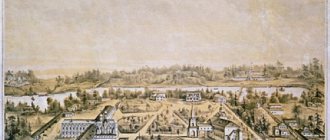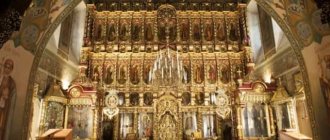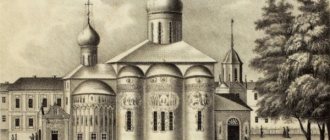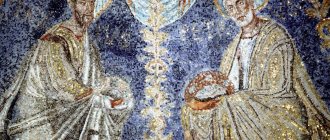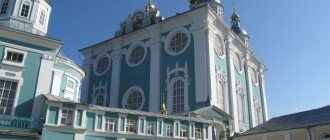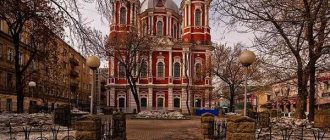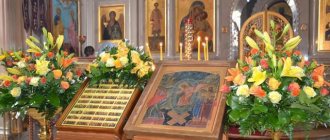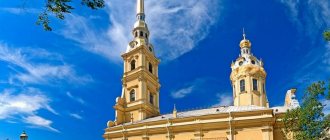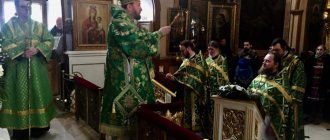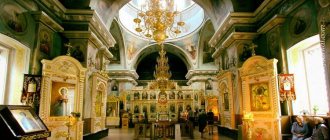| Sergiev Posad Resurrection (Peter and Paul) Church |
Temple in honor of the Resurrection in the city of Sergiev Posad
, often called
the Church of the Supreme Apostles Peter and Paul
, Resurrection Metochion of the Trinity-Sergius Lavra
- Thrones: Resurrection of the Word (main), supreme app. Peter and Paul (altar in the refectory)
- Address: Russia, 141310, Moscow region, Sergiev Posad, st. 1st Shock Army, 17
- Tel.
- Official site:
- On the map: Yandex.Map, Google map
The temple is located in the historical center of the city, in the Kukuevka district, on the territory of the ancient Kalichya Sloboda.
From the northern border of the Lavra to the Church of the Resurrection is about 0.5 km. The original temple on this site was erected by decree of Tsar Alexei Mikhailovich and the blessing of Patriarch Nikon at the expense of the Trinity Sergius Monastery in memory of the thousands of defenders of the monastery who died during the siege of the Lavra by the Polish-Lithuanian army in the Time of Troubles (1608-1610). The wooden Church of the Resurrection of the Word was consecrated in 1654.
In 1775, the dilapidated wooden building was replaced with a new one. In addition, a second temple was built in the settlement, also wooden, consecrated in the name of the apostles Peter and Paul.
After several decades, parishioners raised funds to build a new stone church. Construction work took several years. The consecration of the main altar took place in 1818, in the still unfinished church. Two years later the new church was ready. The temple replaced both of the previous ones, which is why the main altar was consecrated in honor of the Resurrection, and the chapel in the refectory was consecrated in the name of the apostles Peter and Paul. For this reason, the temple became known both as the Resurrection and as the Peter and Paul Church.
By the end of the 19th century, the temple was surrounded by a brick fence with octagonal corner turrets, and in 1902 a western covered brick porch was added to the church.
During the anti-church persecution of the Soviet era, some clergy of the temple accepted death for Christ. Thus, from 1928 to 1931, Hieromartyr Miron Rzhepik served in the church, from 1930 to 1931 - Hieromartyr Nikolai Aristov,
In 1935, the temple was captured by renovationists.
In 1939, by decision of the authorities, the church was closed. The following year, the fence was completely dismantled and the remaining bricks were used for landscaping work at the nearby market. In 1952, the two upper tiers of the bell tower were dismantled. During these years, the temple premises were used for various industries. At the same time, the iconostasis and the entire interior decoration of the temple were completely lost.
In the early 1990s, the church was returned to Orthodox believers. Its restoration began immediately. In 1995, a chapel was erected on the temple site in memory of the fallen soldiers. From 1999 to 2014, three-year Trinity-Sergius theological and catechetical courses operated at the church. At the end of the 2010s, a hotel for pilgrims, a children's educational school and a Sunday school were opened at the temple. The revived temple became the courtyard of the Trinity-Sergius Lavra.
At the beginning of the 21st century, the temple was the only one in Sergiev Posad built according to the canons of classicism at the beginning of the 19th century and was considered an object of cultural heritage of regional significance. Near the temple in 2021, a picturesque park area was landscaped by the city.
Statistics
- 1898 - the temple has more than 180 courtyards with 1143 parishioners
- 1930s - almost 600 people in the parish community
| Sergiev Posad Resurrection Church - Resurrection Metochion of the Trinity-Sergius Lavra |
Architecture
The composition of the Resurrection Church is typical of urban religious buildings built in the Russian provinces in the 18th-19th centuries. It consists of three parts: a single-domed church, a small refectory and a high bell tower, stretched in one line in the direction from east to west. The distinctive elements of the temple are the features of the classicism era. It has clear, geometrically correct shapes characteristic of this style.
Three low semicircular apse projections are attached to the high two-height pillarless quadrangle of the main temple. The facades at the top are completed with laconic triangular pediments. The church is covered by a semicircular vault, topped with a round drum. A small onion-shaped dome on a small graceful neck crowns the temple. Adjacent to the main volume is a small square refectory, the entrances to which from the side of the quadrangle are designed as arched spans. The bell tower is built in three tiers, decreasing from bottom to top.
The decor of the church, mostly classical with some baroque elements, is distinguished by laconic austerity. From the north and south, the entrances to the temple are decorated with porticoes with four columns, which are topped with pediments. The pilars that decorate the building are flattened. The facades of the church are covered with cement plaster. The platbands of large rectangular windows are decorated with niches and protruding cornices - sandriks.
The lost brick fence that surrounded the temple at the end of the 19th century was decorated with octagonal corner two-tier turrets, whose shapes and long spiers were reminiscent of the architectural designs of the Duck Tower of the Lavra.
Peter and Paul, or Resurrection?
Walk a little north of the Lavra gate and you will find yourself at the temple, which is usually called the Church of Peter and Paul. With these names he was included in guidebooks, registered on maps, and even the residents of Sergius Posad themselves are now unlikely to call him anything else. “The historical name of the Church of the Resurrection of Christ has been undeservedly forgotten,” says the new rector, Hieromonk Guriy (Gusev), who replaced 79-year-old Archimandrite German (Chesnokov) in this post.
The fame of his predecessor extends beyond church circles. Who hasn’t heard that on the 1st Shock they give lectures - they cast out demons from those possessed? Sergiev Posad is not the only place where people go for deliverance: chilling images are known where, under the power of the priest’s gaze and words, people fall into a trance, spit, wring their hands, speak in a voice that is not their own and curse in a dark language. There was, there was nothing to hide: one way or another, these images influenced the reputation of the temple as “special”, where locals did not always dare to look.
After Fr. Herman retired with the rank of honorary rector, the lectures stopped, and the flow of sufferers dried up. The successor will reorient the temple towards ordinary local parishioners, and the matter will not be limited to changing the name.
Hieromonk Gury, who comes from an army family, took up work in several areas - from document management to signs on the doors in office premises. He created a legal entity, now it is the Resurrection Compound of the Lavra. He hung street speakers on the fence broadcasting religious services. I moved the sale of souvenirs to a separate shop. And even the walls of the church will be painted a different color: now they are bright blue, but will become warm yellow-ocher.
In other cases they would say: rebranding. And the new rector himself is not the most typical priest in our minds. Having already accepted monasticism, he entered the full-time budgetary department of Moscow Pedagogical University (pedagogical, then named after Lenin), received a diploma as a history teacher and completed graduate school there.
O. Gury meets us at the entrance.
— Would you mind if we took some photos inside?
- Yes, of course, take pictures. Here are several new icons that we placed at the request of parishioners - the icon of the Mother of God “The Inexhaustible Chalice” and the icon of Spyridon of Trimifunt. Our parishioners wanted to pray in front of them, they honor them. Together we collected money for them, as well as for this one, it appeared with us about three weeks ago - the icon of Luke of Crimea.
— How will the temple change externally?
— First of all, I removed the blank fence at the gate. He took the trade out of the temple and made a separate shop for it. An elegant fence and flower beds appeared. During meetings, I ask employees to be extremely polite. A person wants to feel in a welcoming environment, he expects a good attitude towards himself, so that he is not shouted at because he walks on the washed floor. We must return the temple to its original purpose, make it attractive not only to guests, but also to those who live nearby. This is my task as abbot.
—Who are your parishioners today?
“The people who come to us have changed. There are more young people living in the surrounding streets. Possessed, although not always among them there were those who needed help, and simply strange comrades no longer come here. Previously, they were the majority, but now locals have begun to come, there are more of them, they want to have their own temple. Imagine: it stands in the center of the city, this essentially gives it the status of a city cathedral. We remember that some time ago they wanted to build new churches in the city, but lo and behold, it already exists, nearby!
— After external changes, will the atmosphere become different?
“I tell everyone here: there is no need to put on gloomy faces, the Church exists for joy.” We must make a person feel that faith is a consolation. The Apostle Paul taught to rejoice and constantly thank God for everything. The Lord calls us ministers to comfort people, not to frighten people, not to teach religious life as a heavy burden. A person will take on the feat himself, and will do it in order to become better. But, of course, there must also be decorum - a restrained, pious attitude towards the place and towards oneself.
- Where is Fr. now? Herman, why did this change happen?
— He is the honorary rector of the temple, has a cell in the Lavra, in his native monastery. He worked a lot in this position, his parishioners love and respect him. Thanks to the work, charisma, and highest authority of Fr. Herman, the church was restored from ruins, parish life was formed, but at almost 80 years old, he cannot fully bear these concerns, if only for health reasons. Economic activity is still a lot of trouble. The reprimands are supplemented by unction - previously they were based on the strength and charisma of the performer, but without Fr. It makes no sense for Herman to see them through.
This is what the temple looked like in the 1970s
The temple on the street of the 1st Shock Army turns 200 this year, but prayers at this place were performed back in the 17th century. They took place in a wooden church, built shortly after the siege of the Lavra was lifted, in memory of those events. The “Apostolic” name took root later, as Fr. Gury, thanks to one of the chapels of the church, named after Peter and Paul. Its full name is still different - the Church of the Resurrection of Christ.
Vladimir Kryuchev
DIRECT SPEECH
Hieromonk Gury (Gusev), rector:
“Our temple, in fact, is a monument to the people’s feat. The wooden church was built in the 17th century in memory of the defenders of the besieged Lavra, who selflessly broke through the siege, and the stone one appeared later. We have a modern chapel in memory of fallen soldiers. It has been standing since the nineties, but has often been closed. Now the chapel is open constantly, where you can pray in front of the restored icon of Tsar Nicholas II and remember those killed in modern conflicts. There should be such temples in the city - accessible and close, but at the same time preserving pieces of our history, which, like a bridge, connect us with something dear.
Cultural heritage
The Church of Peter and Paul in Sergiev Posad is the only architectural monument in the city that dates back to the era of classicism, built in the 19th century. Unfortunately, after the restoration, plastic doors were installed that did not fit into the historical appearance.
Initially, the temple had an important city-forming role, because for most residents of the settlement it was a home church, where all the most important church sacraments were held.
Today, the Church of Peter and Paul is again the center of attraction for believers. It is open to parishioners every day.
Source
Sergiev Posad. Gethsemane Skete. Unction.
Trip program
7:30 - departure to the Trinity-Sergius Lavra;
— arrival at the Trinity-Sergius Lavra;
— prayer service at the shrine with the relics of St. Sergius of Radonezh in the Holy Trinity Cathedral;
— acquaintance with the Lavra: the Assumption Cathedral, the crypt of the cathedral, where the Patriarchs of Moscow and All Rus' are buried: Alexy I (Simansky) and Pimen (Izvekov), the refectory with the temple in the name of St. Sergius of Radonezh, the gate temple in the name of the Nativity of John the Baptist, the Overkladeznaya chapel above the source, found in 1644, there is a five-tier bell tower;
Meal for donation Transfer to Gethsemane monastery. Unction Optional excursion to the underground church.
Unction, or as it is also called Blessing of Anointing, is a church Sacrament in which, by anointing the body with specially consecrated oil (oil), the grace of God is invoked on a person, healing mental and physical infirmities. The establishment of the Sacrament dates back to apostolic times. The letter of the Apostle James says: “If any of you is sick, let him call the elders of the Church, and let them pray over him, anointing him with oil in the name of the Lord. And the prayer of faith will heal the sick person, and the Lord will raise him up; and if he has committed sins, they will forgive him” (James 5:14-15) - departure to Moscow;
City of KHOTKOVO. Pokrovsky Khotkovsky Convent. Veneration of the relics of St. Cyril and Mary parents of St. Sergius of Radonezh.
This is what is said on the memorial sign installed near the source:
“In his daily prayer, St. Sergius asked the Lord about giving the enslaved Russian people the strength to gain will and reason.
The Lord heeded his prayers and since then, as an enduring sign of the eternal memory of the great prayer of St. Sergius for the Russian land, from the bowels of this mountain, awakened by the power of the spirit, streams of blessed springs began to flow, representing a visible example of the Great Grace, which, by the will of God and the prayers of St. Sergius, descended to this place and which, as commanded for that time, must descend over our entire Russian Land, in order to nourish this ailing land, reaffirming us in will and mind, Spirit and Truth.”
Unction, or as it is also called Blessing of Anointing, is a church Sacrament in which, by anointing the body with specially consecrated oil (oil), the grace of God is invoked on a person, healing mental and physical infirmities. The establishment of the Sacrament dates back to apostolic times.
The letter of the Apostle James says: “If any of you is sick, let him call the elders of the Church, and let them pray over him, anointing him with oil in the name of the Lord.
And the prayer of faith will heal the sick person, and the Lord will raise him up; and if he has committed sins, they will forgive him” (James 5:14-15)
Historical reference
In 1608, a united Polish-Lithuanian army attacked the Trinity Lavra of St. Sergius. The siege lasted a long time, but the walls of the monastery withstood the onslaught of enemies. On the site of the current Peter and Paul Church there was the Konyushennaya Settlement, on the site of which fierce battles repeatedly took place. According to the chroniclers, “the ground in this place is watered with blood, like drops of rain.” In memory of the courage of the defenders of the fortress, a small Ascension Church, built of wood, was consecrated.
By 1820, the building had fallen into disrepair, it was demolished and the brick Church of Peter and Paul (Sergiev Posad) was erected. It was built in the style of classicism, which strikingly distinguished the new temple from other monastery buildings. At the same time, the diagram and plan of the original temple was preserved. Only new aisles appeared on the southern and northern sides.
A peasant from G.A. Kokuev took an active part in the construction of the renovated Peter and Paul Church in Sergiev Posad. Lobov, about which there are records in the church archives.
By the end of the 19th century, the parish numbered 185 households. In the first years of the 20th century, the temple was restored, and a bell tower was erected next to it. But the outbreak of the revolution changed the fate of the church radically. In 1939, despite the admonitions of the parishioners, who according to official data there were 592 people, it was closed, and a few years later the bell tower was blown up. Some of the buildings were dismantled and used for the needs of the city, including the construction of a market.
It is also known about this unique place that in 1920 Hieromonk Alexy lived nearby, after the closure of the Zosimovskaya hermitage. It was this holy man who was entrusted with drawing the lot that determined the fate of Metropolitan Tikhon.
Only in 1990, the rather dilapidated temple without domes, crosses and church utensils was returned to the church. Now it has been restored and services are held again, prayers are offered and chants are heard.
Schedule of services
The Church of Peter and Paul in Sergiev Posad is open to believers every day. Services are held here seven days a week. The liturgy begins at 7:40, and the evening service at 17:00. The sacrament of unction is held daily at 12:00.
A special feature of the Church of Peter and Paul in Sergiev Posad is that every week on Friday, Saturday and Sunday, excluding great holidays, Archimandrite Herman performs the rite of expelling evil spirits. Those possessed by demons are brought here from all over the country. Registration for this event is required in advance.
